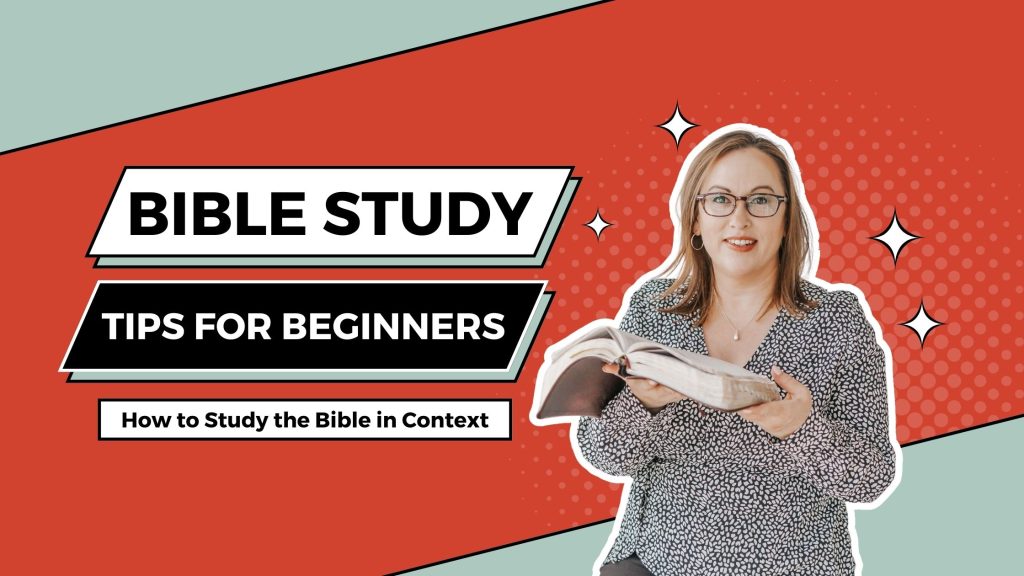When I first learned about the importance of context in Bible study, I opened my Bible to a verse I loved, read it, and thought, “Now what? How do I study the Bible in context?”
Prior to my attempt at studying the Bible for myself, I thought I had a pretty good idea of what this favorite verse meant. But after reading the chapters surrounding my chosen verse, I had more questions than answers. Instead of feeling enlightened, I became discouraged.
Have you ever been more confused after reading a Bible verse in context? Are you convinced that context is important in Bible study, but you don’t know where to begin? Do you feel intimidated by studying the Bible on your own because of your lack of experience, time, or knowledge?
Be encouraged. You can study the Bible for yourself and you can study the Bible in context.
How to Study the Bible in Context
Spiritual truth is spiritually discerned (1 Corinthians 2:14), which means that we cannot lean on our own understanding (Proverbs 3:5–6), but must rely on the teaching of the Holy Spirit (1 John 2:27). Start your study of the Bible with prayer. I like to pray Psalm 119:18 (NIV)—”Open my eyes that I may see wonderful things in your law.” God wants us to understand his Word, so we know this is a prayer he loves to answer!
Read the whole paragraph
Start by reading the whole paragraph surrounding the verse. Sometimes this small portion of extra reading gives us information that completely changes our understanding of a single verse. A good example of this is Philippians 4:13—”I can do all things through him who strengthens me”. Out of context, this verse serves as an effective motto for anyone trying to accomplish a task or endure a challenge. But read in the context of the paragraph (Philippians 4:10-13), we see that this famous verse specifically refers to how God strengthens us as we practice contentment amidst difficult circumstances.
Read the whole book
Though useful in many ways, the chapter and verse divisions in our Bibles can actually hinder our study of the Bible if we forget that they were not a part of the original text. Each verse nestled inside a paragraph is actually a purposeful piece of the entire book, so reading through the book provides the necessary context for the verse.
Our look at 1 John 4:4 in the previous post in this series is an excellent example of this. Out of context, “greater is he that is in you than he that is in the world” sounds like a rallying cry for believers struggling with worldly enemies—Satan or unbelievers. Read in the context of the paragraph, we see that the verse refers to the empowering of God’s Spirit in believers to discern truth from false teaching. When we read the paragraph in the context of the whole book, we understand that John wrote this letter after some people had left to follow false prophets. John wrote the letter to encourage those who remained with the assurance of their salvation and reminders of the truth they already knew. This broader understanding gives deeper meaning to the single verse.
Learn the context within the whole Bible
The whole Bible is God’s message to us. From Genesis to Revelation, God wove a continuous thread that tells his story of redemption. The entire Bible reveals who God is and testifies about Jesus Christ. To fully know him, it’s best to read his entire message.
If you’ve never read the whole Bible, I encourage you to aim for that end. You don’t have to do it in a year. In fact, I quit my Bible-in-a-year reading plan because I prefer to savor it as I go. But do endeavor to read it all because when we read all 66 books contained within the canon of Scripture, we notice life-giving connections and themes that enrich our understanding and knowledge of God.
Familiarizing ourselves with the entirety of Scripture is a lifelong process. Be patient along the way. Little by little, your understanding of God’s Word will deepen. Besides simply reading the Bible from Genesis to Revelation, there are a few practical ways to increase your understanding of biblical context.
Consider the plot of God’s story
A broad outline of the Bible’s story has four “movements”:
- Creation—Where did we come from?
- Fall—What went wrong?
- Redemption—What is the solution to our problem?
- New Creation—Where is history ultimately going?
Every passage of Scripture fits somewhere within this outline. As you read, consider how the passage answers one or more of these four questions. [1]
Notice what the passage reveals about who God is
Because the Bible is God’s story, it reveals his character. Notice what the passage reveals about God’s attributes. Make note of his names, such as “the God who sees” (Genesis 16:13) or “the Lord will provide” (Genesis 22:14).
Trace promises and their fulfillment
A fruitful exercise is to trace the fulfillment of his promises throughout the Bible. He makes promises, and he inevitably fulfills each promise. We can think of the Old Testament as God’s promise of redemption and the New Testament as the fulfillment of his promise through the saving work of Jesus Christ. Many times, we find the fulfillment of his promises in different passages or books of the Bible than the passage in which we read about the original promise.
Read cross-references
Cross-references can help us gain a better understanding of the connections between various passages of Scripture. Many Bibles contain cross-references in the margins. If your Bible doesn’t have cross-references, you can use free online tools and apps like Bible Hub or Blue Letter Bible.
Just this morning, I read Psalm 83, which references specific people and places. The psalm begins by asking God to act because of those who hate him and conspire against his people. The first line of verse 9 says, “Do to them as you did to Midian”. I couldn’t remember anything about Midian, so I referred to the cross-references in the margin of my Bible. This led me to Judges 7:1–24 which tells of the unlikely victory of Gideon and a meager army of 300 men. Equipped with trumpets and the power of God, they overcame the intimidating people of Midian. Now I have a better understanding of verse 9—the psalmist wants God to provide a miracle of victory in an impossible situation. In just a few minutes of extra reading, a psalm that previously meant little to me now fills my mind with exciting pictures of God’s deliverance of his people.
Look at different types of context
In the next post of this series, we’ll explore historical, cultural, geographical, literary, and language contexts in Bible study. Stay tuned!
You Can Study the Bible in Context!
If you can read, you can study the Bible in context—without any previous knowledge, experience, or extra resources. Simply read and observe the text in the context of its paragraph, the book, and the Bible as a whole. If it seems like a slow process, be patient. The more of the Bible you read and study, the more you’ll understand.
Remember this: God wants you to understand his Word, so trust in him and the help of the Holy Spirit, then keep on keeping on and wait for him to open your eyes to the wonders of his Word.
[1] Bouma, J. (2018, April 28). How to Read the Bible in Context. Zondervan Academic. https://zondervanacademic.com/blog/bible-context






2 Responses
Love this!
I was hoping to hear your voice in the video. Maybe next time 😉
Thank you for taking the time to teach us what you have learned to be valuable as you study His word and seek to understand!
It’s my pleasure to share what I’ve learned about God’s Word! That’s a main reason this website exists, so I’m blessed you enjoyed this post. And yes, I’d like to include my voice in future videos. Baby steps! I can only handle creating so much content at a time, so I’m learning and growing continually.